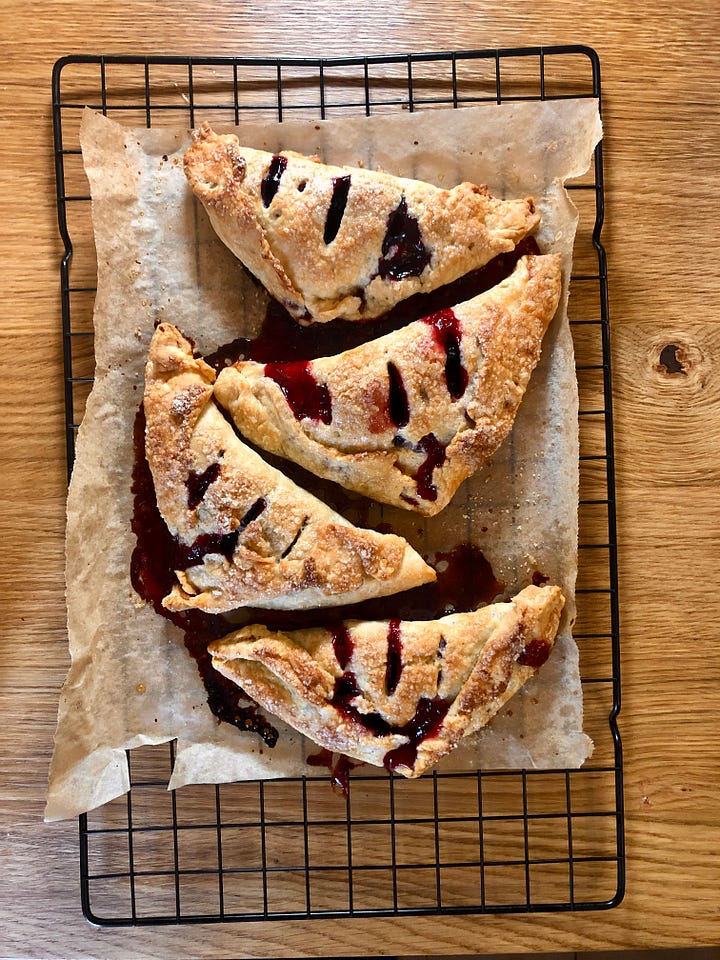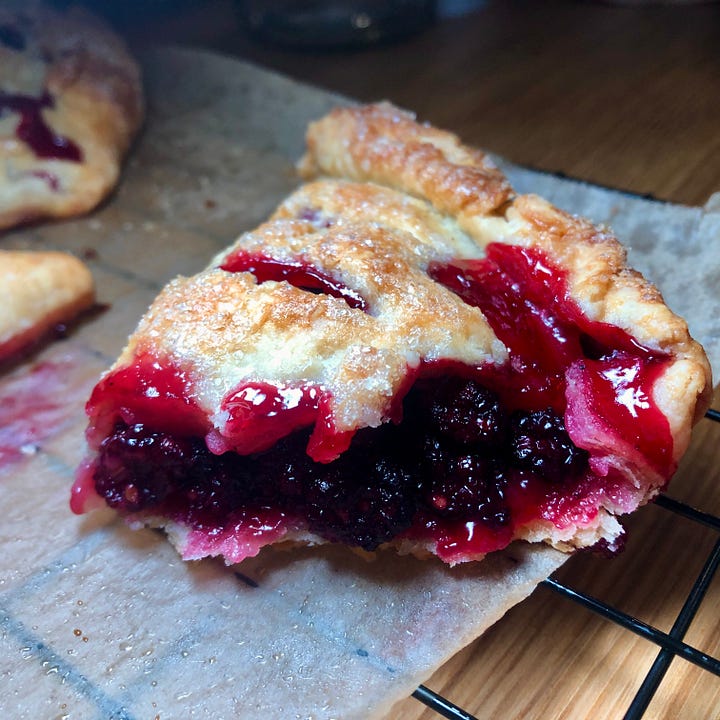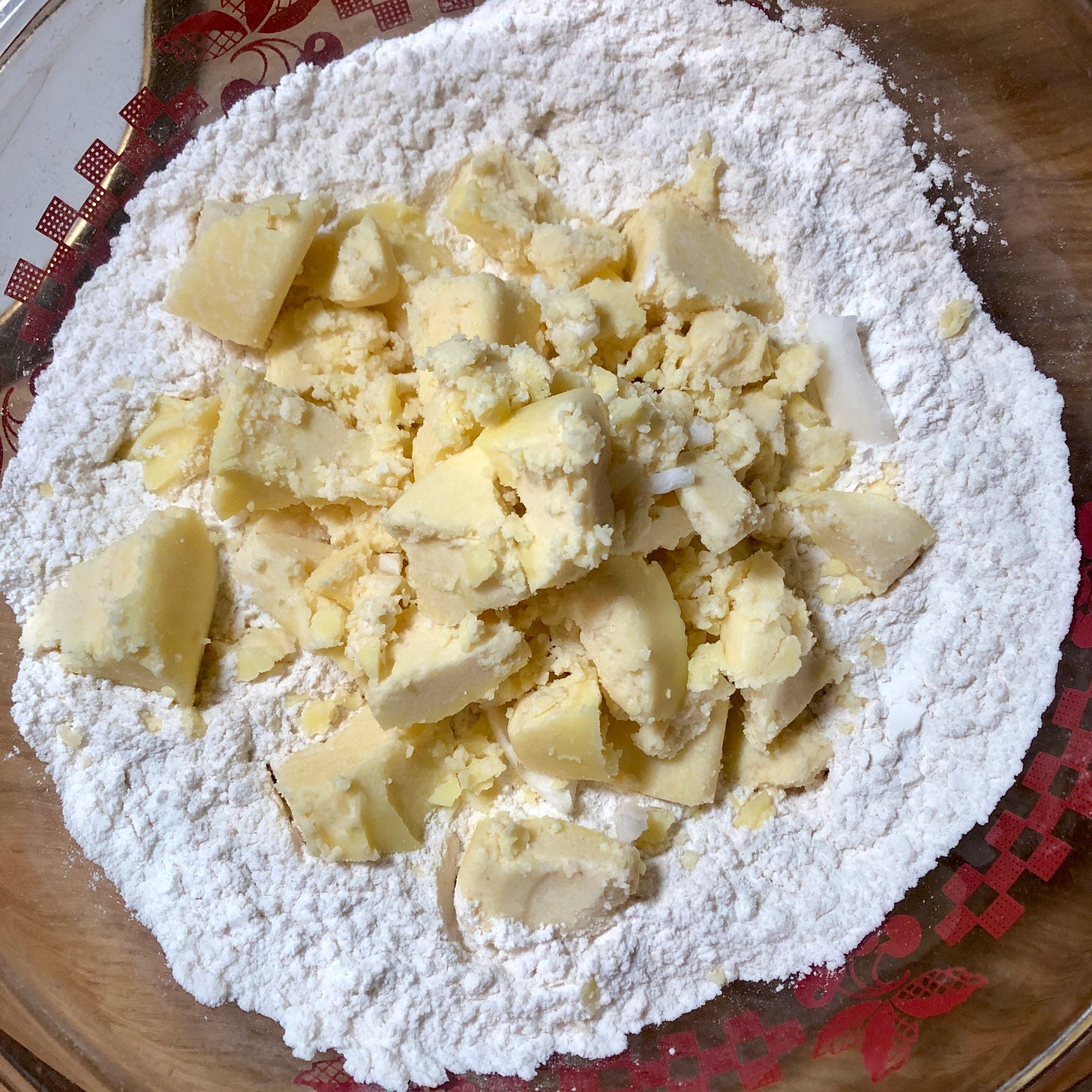Whoa, time got away from me, I’m so late with this update from June! Still, I’m pressing on, because I need you to know about mulberries, man. I mean, maybe you know about them already. But I’m newly mulberry-pilled and I’ve got to proselytize!
Given my otherwise classic spacey vegan fermentation-enthusiast presentation, you might assume I’m also an expert urban forager. But aside from the garlic mustard I wrote about in April, I’m lightly ashamed to say I’ve never really foraged at all. I’m kind of a weenie about it if I’m honest — I’m scared of getting poisoned and wasn’t sure if I could trust myself to stare hard enough at the world around me to reliably pick the right thing. But I was at Christie Pits with my friend Kristan one day in June and we noticed around the same time that the tree above us was full of berries. We muttered half to each other, half to ourselves, “Are they mulberries? Maybe?” Kristan and I both have complicated obsessions with Alison Roman, and this late-stage perception of the fruit was in both of our cases due to the mention of mulberries in Roman’s Sweet Enough. For her Blueberry Cornmeal Tart, Roman suggests that you can mix in “mulberries/huckleberries (if you’re lucky to find either).” Were we lucky? We weren’t sure. I said I’d get my partner David to deploy his plant identification app when next I saw such a tree and report back.
The very next day I saw the berries in the selfsame park where I got the garlic mustard; a minute’s walk from where I live, where we’ve walked almost daily in the summer for the past ten years. And yet in all of those years I never noticed this cute little tree hanging out all alone on the side of the hill, surrounded by birds gorging on its fruit?? Shocking! David didn’t have his phone on the walk, so I picked a couple berries for home identification. But on our next lap around the track we saw a man with a long, white ponytail happily helping himself to the abundant berries, definitely not dropping dead. And that’s when I knew: this was mulberry town!
Now that I knew what was up, I got down to researching how mulberries worked, how long they lasted, how they tasted best. I quickly learned that they only last a day or two in the fridge, so I’d either have to freeze them or use them up fast. This is why you don’t often see mulberries for sale. Their short shelf life means they’re not commercially viable.
Upon reporting this to David, he said, “So mulberries are anti-capitalist,” in this cool, dry, very David way. “Yes!” I said in a way-too-excited, classically Julia way, bowled over with delight at both the berries and my choice of life partner.
For the next week or so, I was obsessed. Obviously mulberries are anti-capitalist in the sense that they’re free gorgeous fruit. They also all ripen at different times, over the course of a few weeks, so it’s kind of impossible for one person or one bird to harvest them all in one go and leave nothing for anyone else. I spent at least an hour each day out in the park picking mulberries and learning the many other lessons they had to teach.
For example, those berries reminded me how to take it slow and really look. Every time I thought I’d gotten all the berries ripe for the picking that day, I would do what I thought was one last scan of the branches weaving gently in the breeze, and there would be another cluster, ready to go, that hadn’t revealed itself before. This looking required a somehow simultaneous tuning out and honing in that reminded me a lot of what I do with my brain when I’m really writing hard.
Since May’s foot health kick, I’ve been in a general phase of trying to get more Nutritious Movement, a term coined by cult biomechanist Katy Bowman. Bowman argues that the way many humans currently live — mostly sedentary; exercising in short, concentrated bouts; rarely squatting; crammed into shoes — fucks with our bodies along the lines of orcas held captive. Our metaphorical dorsal fins are similarly flopped. Two of the many movements Bowman says we don’t do enough are reaching and hanging (from tree branches and such). My hanging practice remains non-existent, but the mulberries gave my reaching skills a workout. I was indeed shocked at the little muscles that got worked simply by aiming for some ripe guys higher up.
On the flip side, sometimes no matter how much I pushed my reaching capacity, there were troves of berries that were simply too high. I had to let them go, allow a mildly disappointing reality to simply be. Another good little muscle to work.
The mulberries also got me communing with my neighbourhood elders. Over the week, I spoke to at least five different older people out for their constitutional around the park’s track. Normally I don’t love when strangers approach me to chat, but I was typically in such a vibey mood when I’d been out picking in the soupy heat for a while, and I found myself thrilled to answer their questions and offer them a berry to try. It surprised me that it was me, in my mid-forties, telling women in their seventies about the magic of these trees. But the latter are of course of the generation that was able to somewhat break free from compulsory domesticity, leave the drudgery of their mothers’ endless jam-making behind. Maybe a generation of mulberry-ignorers makes sense. I’m glad to have the freedom to choose to spend my free time slowly picking berries and making pies from scratch, rather than being conscripted to do so.
Which brings me to pies! I mentioned that I’m low-key veganizing my way through Sweet Enough, but I’ve been procrastinating on the pie chapter because I didn’t feel like perfecting my crust. I’ve tried it before with limited success; I hate to do something messy and fussy and have it fail. But I wanted to treat my beloved mulberries with reverence, make them into an extra-special treat before they spoiled. Their quick-to-perish nature gave me the deadline I needed to dive in and go. You can read all about it in the Eating section below.
I’d meant to send this before mulberry season was gone, but it’s on the wane now, at least for many of us. If you don’t already do so religiously, I recommend keeping an eye peeled next June for a tree full of berries, or a sidewalk stained with their pulp and juice. This is, in my opinion, a really good cult to join.
Reading:
I’ve written many times in this newsletter about the first-draft-in-three-months program I did with novelist and writing coach,
. Without it, I wouldn’t have made nearly the progress I’ve made on my current book in two short years. I also hired her last spring to read the first third of my second draft, just to get a little feedback and, if warranted, encouragement to press on. She provided both in an extremely helpful, sensitive, professional manner, and I continue to recommend her coaching and editing services without reservation. But until June, I hadn’t read any fiction Heidi had written herself.One of the reasons I think Heidi and I work so well together is because she, like me, has spent a big percentage of her life writing full honking books without publishing them. She understands the weird drive that’s kept me going for two decades in the face of some pretty frustrating learning curves, very little external validation, and no shortage of failure. Because of our somewhat similar paths, there wasn’t much of Heidi’s out there to read when I hired her. I just had to believe she knew of what she spoke. I really had to believe in something when I embarked on that fresh first draft.
When Heidi launched her debut novel, The Mother Act, in May, I admit I was nervous. What if the book was bad? Would I still be able to trust the roadmap we’d worked on together? Would I end up swerving off? Well, I read the book in June, and I’m thrilled to report Heidi knows of what she speaks. Her novel is intricately structured, populated with complex characters speaking snappy dialogue; there are multiple well-drawn settings I can easily picture in my mind, and enough narrative tension to keep the pages turning as the backstory of the protagonists slowly unfolds.
As the title implies, the book is about motherhood. Specifically a mother who rather wholesale rejects the role after she’s had a child, as well as the effect that rejection has on her daughter and others in her life. But trying to summarize the content does the book no favours. Heidi’s point is that such a story, such a choice, is difficult and nuanced, not reducible to a soundbite. In other words, excellent novel material. Read it!
Writing:
Speaking of Heidi’s program, the structural framework she suggests hanging your first draft around names the second two beats (or sections) of Act Two “Suffering” and “Letting Go.” In her program, she warns that “Suffering” may indeed cause a little of the same in the writer. In my case, it was no exception — revising this beat was tough. I mean, they’re all tough in their own way, but in order to get my protagonist’s dark night of the soul on the page I had to rummage around pretty thoroughly in my own darkness and then — the really fun part! — return to it over and over, tidying the blood and guts into a neat pattern, at once relatable and unique. Hot! Suffering! summer!
But I made it through to “Letting Go” in June, and celebrated on July 1st with a little self-mythologizing on Instagram. I actually filmed myself working on a patio for a full eleven minutes using my Photo Booth app and noticed that, in addition to lip-syncing and light chair dancing in public, I do an awfully weird thing with my mouth when I write, omg. If you ever see me out working in Toronto, please, just avert your eyes haha!
Eating:
To honour my mulberries, I decided to take a stab at the Black and Blue Hand Pies in Alison Roman’s Sweet Enough and finally get this vegan pie crust show on the road. Roman has a pie crust she publishes in every book she puts out, “The Only Pie Crust,” an all-butter creation that relies on the technique of smushing cold butter into flour by hand to form big, flat, shaggy chunks. As such, I needed a butter that would chill well, smush well, and taste good. Look, I know I people have long used both Earth Balance and Miyoko’s vegan butters to good effect in pastry. But I don’t love the taste of the former, and the latter is expensive plus I’m unsettled by the ousting of Miyoko from her own brand. Plus I’m just a try-hard weirdo who loves making things harder on myself than they have to be, so naturally I made the butter myself.
If you followed my Cookie Week escapades, you know my go-to butter for simple bakes is just twenty percent vegan yogurt, eighty percent coconut oil, inspired very much by
’s simple “baking fat.” But having tried this butter in pastry in the past, I found it didn’t smush very well, and I couldn’t make the kind of shaggy texture Roman demonstrates. I decided this time to draw on a bunch of ideas picked up from classic vegan butter recipes through the ages, especially Nina’s aquafaba butter, first published around 2015, and the cultured butter from good ol’ Veganbaking.net. I very foolishly forgot to write down exact proportions as I went, but I’m pretty sure it was about like this:¼ cup Silk almond yogurt
½ cup plus 2tbsp coconut oil
2 tbsp cold pressed canola oil (for the gorgeous colour and flavour, too)
½ tsp psyllium husks, not powdered, just let it grind in the blender (helps with plasticity, aka smush-ability)
Teeny pinch salt
2 tbsp aquafaba (to emulsify)
I put all the ingredients in a tall measuring cup, immersion-blended for about a minute, froze in a couple small containers, let it warm up in the fridge, then cut into cubes. Isn’t she gorgeous?
The butter smushed like a dream, I got those big fat flakes. I wish I’d taken more pics, but I was kind of zen-ing out watching Roman’s video and pie queen Erin Jeanne McDowell’s similar approach on alternating repeat, smushing and tossing and chilling and rolling. Bliss.


This crust turned out frankly lit. The day I made it, David’s very nice former student was coming over to meet our cat, Emma, who he’d be looking after when we went away in July. I immediately foisted the pie on him and demanded opinions because I’m very cool and fun. He said, “Flaky! Delicious! Would not have known it wasn’t butter! I didn’t know you could make vegan butter!” I was, of course, thrilled, and went on to talk his ear off about how I’d gotten the mulberries from the park across the street, and how I’d gone full park core here and used sumac instead of lime zest in the recipe, all of which this lovely twenty-something linguistics major took in stride. To be clear, I didn’t forage the sumac myself, but it grows in abundance in the same park as the berries, and I’m coming for it in the fall, it’s time! Park pies, baby!
So why, you might ask, did I have to make another vegan pie crust when this one came out great? The truth is, I’ve been thinking about my reliance on coconut oil for a while now, and that kicked into high gear in the winter when
who writes the excellent newsletter commented on my shortbread post and asked if I’d tried using other types of oil that might be better health wise. He shared that he’d been using unrefined canola in his shortbread to great effect. I’d also been thinking about the environmental aspects of shipping tropical oil around the world partly thanks to the work of Alicia Kennedy and . Plus, again, I love a challenge.I had tried Isa Chandra Moskowitz’s frozen olive oil trick long ago, and thought I might give that another go. But first I decided to google “oil-based pie crusts” just to see if I’d missed anything, and holy shit had I ever. So many people, I’m talking women from the American mid-west, have always sworn by, continue to swear by, the pie crust recipe from the Wesson Oil Cook Book from 1955. Like, better than butter, better than lard they say. Whoa. Okay!
When the book came out, Wesson Oil was pressed from cottonseeds, but these days it’s a mix of canola, soy, sunflower, etc. People are riffing on this crust all over the place, with olive oil, non-dairy milks, whatever, and still ending up with crusts they stand behind. I had to give it a try. That night! Sometimes my ADHD brain is like this. There I was, eleven pm, measuring together canola oil and soy milk but not stirring, rolling the crust between sheets of wax paper (necessary!), and swearing my way through the shaping of the handpies, because wow, as fast and easy as this crust is to make, it’s equally hard as fuck to work with. It’s extremely friable, impossible to flute, rips all over the damn place. That first attempt was not too pretty.
Still! It was pretty goddamn good, especially given that I went from fevered googling to finished pie in less than two hours. No chilling required! Plus I could make it with locally grown canola oil, fulfilling my fantasy of being the person in my community who can still make delicious things post-industrial collapse lol. (If you’re squeamish about seed oils, please read the amazing
on the subject right here for a nice spicy take that I happen to agree with).I made another batch of mulberry pies, half with “butter” crust, half with my riff on the Wesson classic (I curdled my soy milk with a little vinegar for a little flavour, but largely followed this version), photographed neither (??), and brought them to my parents’ place for another fun forced taste test. To my surprise, when my omnivore parents gamely considered both crusts, they both liked the Wesson-inspired one better. David, fellow vegan, preferred the butter crust. I think the butter won for me as well, but I’ll tell you it’s close! They’re different, but both really good. The long and the short of it is I’m not afraid of vegan pie crust any more! Which is awesome because I’ve got a bunch more mulberries in the freezer and the peaches are coming!
Okay, this got long, sorry sorry. I think I’ll do a big summer food round-up sometime in August, including a recipe or two, and then get back to my regular schedule in the fall. I hope your summers are going great, thank you so much for reading, mulberries forever, let’s go!











Love to spread the gospel of seed oils :-)
The pie crust adventure genuinely had me on the edge of my seat, I’ll have to rethink my pie approach now! Thank you for that 😊